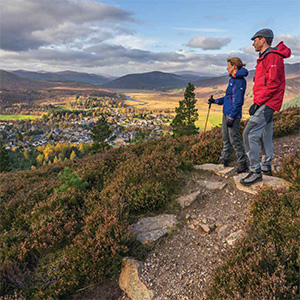Priority 2: Deer Management
There has been a longstanding policy ambition in the Cairngorms to manage deer at levels that protect and enhance habitats, from the Cairngorms Working Party (1992) through to current National Park policy
Deer management is integral to delivering the public interest priorities set out in the Partnership Plan. These include priorities for woodland expansion (both productive and montane woodland), peatland restoration and designated sites, as well as employment.
Through the period of this Plan we aim to continue the current direction of travel in which deer numbers and consequent impacts are reduced, where deer welfare is improved and sport stalking in a high quality environment continues to make a valuable economic contribution in the National Park. In the longer term this will lead to having fewer, good quality deer in a better quality environment.
Deer Management Groups Covering The Cairngorms National Park
Reproduced by permission of Ordnance Survey on behalf of HMSO. © Crown copyright and database right 2016. All rights reserved. Ordnance Survey Licence number 100040965 Cairngorms National Park Authority. © Forestry Commission Scotland. © SNH.
Agenda For Action
We recognise the challenges that continuing the transition to a long-term direction of maintaining lower deer numbers brings for some managers, both in practical implementation and management objectives.
During the period of this Plan we will work with land managers and deer management groups to use population modelling, adaptive management and monitoring to demonstrate whether a more balanced ratio of stags to hinds can deliver reduced impacts and welfare benefits while maintaining a sport stalking resource.
Public agencies will support delivery through deer management groups by:
- Providing clarity on the public interest priorities and developing spatial mapping approaches to show these;
- Supporting the use of population modelling, herbivore impact assessments and habitat monitoring to inform management;
- Supporting an adaptive approach by monitoring the habitat, economic and welfare implications of changes in the context of the Deer Code;
- Supporting greater co-ordination of roe deer management and associated habitat and economic benefits, and collation of
population information on all deer species; - Supporting deer management groups and facilitating communication and joint action across deer management group boundaries where necessary.


